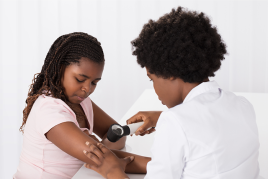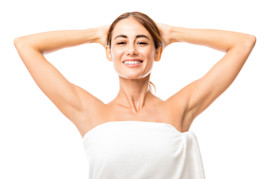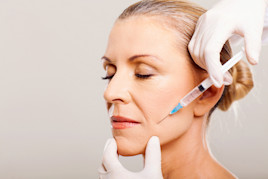Should I add anything to the bath of a child who has eczema?
How to make a bath comfortable
Amy Paller, MD, FAAD, a dermatologist, talks about things you may already have at home that can treat a skin infection or make a bath more comfortable.
(A transcript of the video above)
Should I add anything to the bath of a child who has eczema?
Putting additives into the bath can be very helpful. dermatologists don’t use a lot of bath oils. They minimally will help with moisturizing the skin, and they can make the bathtub slippery.
However, we do like to add agents that are antibacterial, particularly in those children with moderate to severe eczema who have a risk of recurrent infections.
Staph aureus is a bacterium that colonizes — or is almost always found on the surface of the skin and often too inside of the nose — in individuals who have eczema.
Studies have shown that if we add a little bit of bleach to the bath water, we can improve the eczema. We know that children and adults with eczema have staph aureus, a particular bacterium, on their skin when one just cultures an area that’s affected and oftentimes even areas that don’t show lesions of eczema.
And, we also know that staph aureus is not just sitting there waiting to overgrow and turn into an infection, but also drives the inflammation of eczema and the itching related to it. So we think that the bleach bath is working by decreasing the numbers of bacteria on the skin. Therefore, we think the bleach baths not only decrease the risk of infection, but most importantly as shown in trials, actually improve the eczema.
Making a bleach bath is so easy. It’s just a matter of putting a little bit of bleach into the bath water, as follows:
Standard-sized bathtub (full)
When you fill the tub until the water reaches the overflow drain, as shown in this picture, you add:
- 1/2 cup of regular (not concentrated) bleach

Standard-sized bathtub (1/2 full)
When you fill the tub halfway, you add:
- 1/4 cup of regular (not concentrated) bleach

Baby (or toddler) bathtub
Fill the tub as you normally do, adding:
- 1 teaspoon of regular (not concentrated) bleach for each gallon of water
Unsure how many gallons the tub holds? Check with your child’s dermatologist before adding bleach.

Important note
While your child soaks in the bleach bath, be sure that your child’s hands and feet get wet. This is so important because these are areas that can show crusting and overgrowth of bacteria.
We also know from studies that the bleach water should also be applied, perhaps with a little washcloth, to the head and neck — areas that may not be submerged in the bath water — but can benefit from the exposure and decreased numbers of bacteria on the skin.
Interestingly there’s been recent evidence that the dilute bleach bath may do something more than just decrease bacteria. It may actually more directly suppress some of the inflammation. And we look forward to more studies to test that.
Sometimes the bleach baths can be uncomfortable, particularly for those children who have an infection — areas of skin that are open and sore. So in those cases, particularly if I see evidence of infection upfront, I might treat with a course of antibiotics and wait several days before starting the bleach baths.
Warning
The bleach bath is not a quick turnaround fix.
It’s part of a maintenance regimen. It needs to be used on an ongoing basis, perhaps 2 times a week or 3 times a week. But in more severely affected children who do get recurrent infections and have evidence of crusting every so often, you really can do this daily with even better control.
People may use a different type of additive and that is dilute vinegar baths. I have found this to also be helpful for patients.
Finally, sometimes when children are uncomfortable in the bathtub, adding a big handful of baking soda can be soothing. This in itself doesn’t particularly have the antibacterial properties of a bleach bath, but can be soothing. I’ve heard of Epsom salts being used as well.
These are all very easy, inexpensive ways to make the bath into a tool for helping the eczema.
Related AAD resources
Images
Getty Images
Last updated: 3/11/21
 Molluscum contagiosum: How to safely treat it
Molluscum contagiosum: How to safely treat it
 Biosimilars: 14 FAQs
Biosimilars: 14 FAQs
 Practice Safe Sun
Practice Safe Sun
 Relieve uncontrollably itchy skin
Relieve uncontrollably itchy skin
 Fade dark spots
Fade dark spots
 Untreatable razor bumps or acne?
Untreatable razor bumps or acne?
 Laser hair removal
Laser hair removal
 Scar treatment
Scar treatment
 Botox
Botox
 Free materials to help raise skin cancer awareness
Free materials to help raise skin cancer awareness
 Dermatologist-approved lesson plans, activities you can use
Dermatologist-approved lesson plans, activities you can use
 Find a Dermatologist
Find a Dermatologist
 What is a dermatologist?
What is a dermatologist?